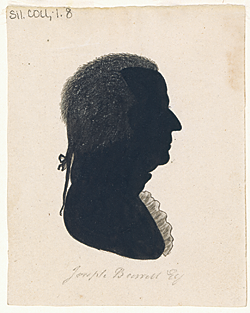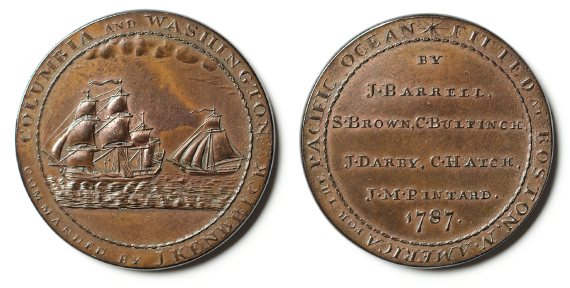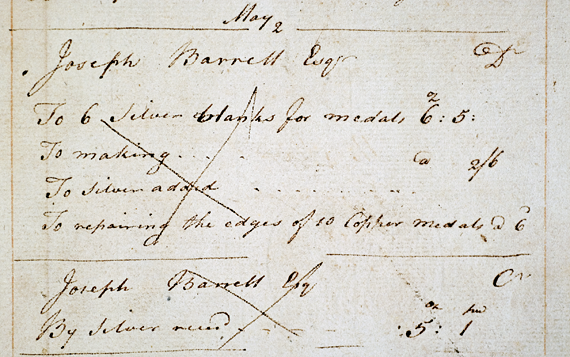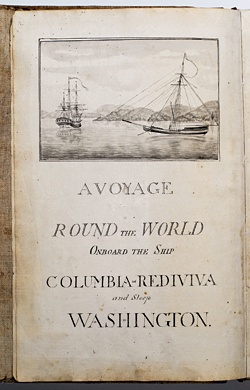 |
 |
 |
 |
|
by Peter Drummey and Anne E. Bentley
|
 |
 |
 |
Joseph Barrell (1740–1804), silhouette by an unidentified artist, ca. 1790. Black ink with ink, China white, and graphite additions. From the Bulfinch family papers, Massachusetts Historical Society.
|
The Massachusetts Historical Society is primarily a manuscript repository holding the papers of individuals and families that document the entire course of American history. The Society’s 1791 founding date means that in many instances it collected materials for the study of epochal events as they occurred. When the crews of the ships Columbia-Rediviva and Lady Washington set sail for Canton in September 1787 to open the Boston-China trade, they took with them medals struck to commemorate their “adventure” and—practical Yankees that they were—to exchange for goods along the way. Soon after the Columbia’s return to Boston in August 1790, the sponsors of the voyage sent a specimen of the medal to the newly-formed Historical Society in Boston, where it became one of the Society’s earliest numismatic acquisitions.
At the close of the Revolution, no longer subject to the monopoly of the British East India Company, New England merchants were eager to trade with the East Indies and with Canton in particular. The problem they faced was to secure desirable trade goods for sale in China. The ship Columbia and its consort, the sloop Lady Washington, sailed by way of Cape Horn to the Northwest Coast (giving the Columbia River its name on a later voyage) where they traded for sea otter furs, highly prized in China, and then on to the Hawaiian islands for sandalwood, and on to Canton. The Lady Washington stayed in the Pacific and made an unsuccessful attempt to open contact with Japan, but the Columbia returned triumphantly to Boston by sailing across the Indian Ocean and around the Cape of Good Hope, the first circumnavigation by an American-flagged ship. This first venture in the Boston-China trade was a commercial failure, but it did not stymie the enthusiasm of the ship’s financial backers, and in September 1790, only six weeks later, the Columbia was off again, on another multi-year voyage to Canton.
|
 |
 |
Copper Columbia-Washington medal, design attributed to Joseph Barrell (1740–1804); dies attributed to Joseph Callender, Boston, 1787 (second reverse with filed edges). Gift of Joseph Barrell, who commissioned the medal, on behalf of the merchants who sponsored that voyage, 1791, Massachusetts Historical Society.
|
 |
 |
May 2, 1789, entry in Paul Revere’s workshop waste book, 1783–1787, for 5 shillings “to repairing the edges of 10 Copper medals.” Revere family papers, vol. 2, Massachusetts Historical Society.
|
 |
 |
 |
Robert Haswell (1768–1801), Manuscript title page for his logbook, “A Voyage Round the World Onboard the Ship Columbia-Rediviva and Sloop Washington, September 1787–June 1789.” Manuscript, 144 pages. 12-3/4 x 8 inches. Massachusetts Historical Society. Robert Haswell was the eighteen-year-old third mate of the Columbia when he began his illustrated “log” in September 1787.
|
Boston merchant Joseph Barrell (1740–1804) was the chief partner in the voyages of the Columbia. Barrell and his business partners in the 1787 voyage, which included architect Charles Bulfinch, were inspired by the Royal Society’s medals commemorating explorer James Cook’s voyages. They had a medal struck “to commemorate the first American Adventure on the Pacific Ocean,” and “to be distributed amongst the Natives on the North West Coast of America.”1 The Columbia and Washington medal is believed to have been designed by Barrell himself and is considered to be the country’s first die-struck medal issued after Independence.
In letters to his brother-in-law, Samuel Blatchley Webb, Barrell documented the difficulty the inexpert die-maker encountered in striking medals from the dies.
When the Columbia set sail on September 30, 1787, Barrell managed to ship about three hundred pewter medals to distribute during the course of the voyage, but a replacement reverse die was injured before it could be used. His third attempt was more successful, but he was disappointed in the quality of the silver medals and noted that if Webb “let a Silver smith file and polish the edges of your [copper] Medal and have it properly cleaned, it will look better than the Silver one.”2 Barrell took his own advice, sending ten of his copper medals to Paul Revere for filing and polishing, as noted in Revere’s waste book entry of May 2, 1789.
|
On December 21, 1791, Joseph Barrell, on behalf of the partners in the venture, presented one of his copper medals, complete with the edge treated by Paul Revere, to the newly formed Historical Society. By that date, the Columbia had rejoined the Lady Washington on the Northwest Coast, thousands of miles into her second voyage to China.
All three of the Historical Society’s specimens of the Columbia and Washington medal was featured in Precious Metals, an exhibition of the Society’s numismatic treasures, and was on display at the Society’s headquarters in Boston, Mass., from August 2 through October 2, 2010. For more information call 617.536.1608 or visit www.masshist.org.
|
|
 |
Peter Drummey is the Stephen T. Riley Librarian and Anne E. Bentley is curator of art at the Massachusetts Historical Society.
|
|
 |
|
1. Joseph Barrell to John Adams, Boston, November 24, 1787, in letter accompanying a presentation medal. Adams family papers, Massachusetts Historical Society, Boston.
2. Joseph Barrell to Samuel Blatchley Webb, Boston, December 8, 1787, in Family Letters of Samuel Blatchley Webb (New York: 1912), 353.
|
|
|